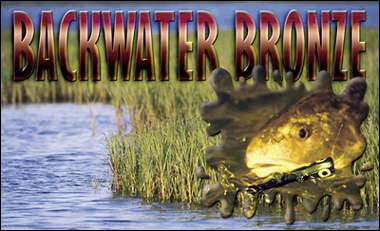
When fall redfish take to the marsh,
it's time to take 'em on top.
By Chester Moore, Jr.
Page 2
Our first stop was along a shallow shoreline adjacent to a small drain. Holder said the reds held there quite a bit. The action was slow, however, so we eased farther down the bank until Holder suddenly noticed a ripple in the water.
"Throw there," he matter-of-factly instructed. "There's a school of redfish."
I noticed the ripple, but couldn't make out the reds. I threw my bone-colored Rebel Jumpin' Minnow toward the action and couldn't believe what came next. A big school of reds surfaced under the bait, and several of them slammed it so hard that it sailed a good 5 feet out of the water. When it landed, one of the reds hammered it again, but this time got hooked up.
Holder soon connected with another. We had a double-header, and the morning had just begun. God was definitely smiling down on us that day.
By the time we'd battled our reds, the school had spooked and moved on. So, we moved, too. Our next stop was in a shallow flat hidden deep in the marsh.
The water was clear here, and we could actually see the redfish swimming around. But, before I could make the first cast Holder gave me some instructions.
"Your best bet here is to throw just in front of the reds and let them come up to it," he said. "Walk the bait real good and they'll go crazy."
I did just as he told me, and it wasn't long before I found myself hooked up with another nice fish. In the ultra-shallow water the red's battle was impressive. It made long, determined runs and kicked up lots of water with its broad, blue-tinged tail. Truly a beautiful sight.
In the course of the day we both limited out on redfish by fishing with topwater plugs. The fishing was great, but the best part for me was listening to Holder share his intimate knowledge of redfish and, in particular, how to catch them on topwaters.
His most compelling observation was what he calls the redfish "cone of vision." This is the zone that an angler should try to work around when sight-casting to reds. If a redfish's head were a clock, its eyes would be at 2 and 10 o'clock. The fish can basically see to 4 o'clock on the right side and 8 o'clock on the left, but 5, 6 and 7 o'clock are blind spots.
An angler should always make a point to throw the bait directly in front of the fish or even with its head. The fish may strike at the bait if it hears it hit behind the eyes, but Holder says the combination of seeing and hearing the action of a topwater plug is what will drive a redfish to hit most of the time.
With this in mind, it's worth noting that it's almost a miracle of physics for a redfish to strike a bait on the surface. The mouth of a red is designed to descend downward to feed on crustaceans on the bottom, not extend outward to gulp up schooling fish. If you watch closely you can see the fish turn slightly to the side so they can strike the bait. Either the reds have evolved this ability over the years or Nature just goofed up somewhere down the line.
Another interesting note shared by Holder is in regard to the movement of schools of redfish in marshy lakes like those in the Keith Lake Chain. Holder is a veteran airplane pilot, and says that while flying over these areas you can easily make out long mud trails in the water. These trails denote where schools of redfish are rooting up crabs and small baitfish. By wearing polarized sunglasses and paying attention to subtle changes in water clarity an angler can make out these trails, and may actually be able to follow the schools.
After the first few strong cold fronts move through, redfish schooling activity may be such that almost anyone can find them. When they get to feeding in a frenzy, a school of reds may look like more like an emerging submarine than a bunch of fish. In early fall, however, this isn't always the case.
Look for subtle signs. A small mud boil may mean a lone redfish on the prowl. A ripple in the water can lead to a large school of aggressively feeding reds. Think small in early fall to find big numbers of redfish.
Fall is a period of migration for baitfish, so focus on areas in the marsh where drains meet open water or where drains may crisscross. These spots often hold the most redfish. One of the best spots I've ever fished is where a long, winding cut feeds into open water over an oyster reef. This spot is always good for reds in the fall because the shrimp come out of the marsh on outgoing tides, and there are lots of crabs around the reef.
It may be hard to drag yourself away from the easy action of schoolie trout feeding under the birds this fall, but if you want to feel true pole-bending power and see your topwater plug get violated slip into the marsh and find some redfish.
There are lots of them around nowadays, and they'll do things even the biggest trout cannot dream of.
# # # #
page 1 / page 2
| 




